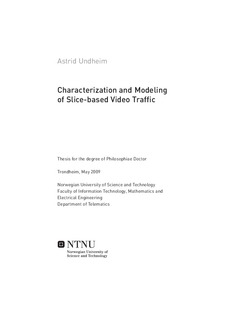| dc.contributor.author | Undheim, Astrid | nb_NO |
| dc.date.accessioned | 2014-12-19T14:11:36Z | |
| dc.date.available | 2014-12-19T14:11:36Z | |
| dc.date.created | 2009-08-06 | nb_NO |
| dc.date.issued | 2009 | nb_NO |
| dc.identifier | 228817 | nb_NO |
| dc.identifier.isbn | 978-82-471-1564-0 (printed ver.) | nb_NO |
| dc.identifier.isbn | 978-82-471-1565-7 (electronic ver.) | nb_NO |
| dc.identifier.uri | http://hdl.handle.net/11250/261501 | |
| dc.description.abstract | The interest in watching real-time video content transmitted over packet-based communication networks such as the Internet is growing. When resources are restricted, quality of service support and provisioning of service guarantees are needed in the network to ensure a satisfactory user experience. In addition, the video content, different choices made in the video encoding, the bitrate characteristics of the resulting video stream, and the network performance will have an influence on the perceived quality. Regarding the network performance, the packet loss ratio and packet loss distribution are identified as important performance parameters for real-time video, and are of particular interest. Estimating these parameters is a step towards assessing the perceived quality of service for a video transmission.
This thesis addresses issues related to video transmission over the Internet. In particular, new methods to characterize and analyze video traffic in a network perspective are proposed in order to estimate some key network performance parameters. This requires models of the traffic and the network elements. Video encoded using a newly developed slice-based H.264/AVC scheme is studied. This scheme intends to give less bursty video traffic, and will hence be favorable for encoding video to be transmitted over a resource constrained network.
Video clips encoded using this slice-based scheme are characterized using two different approaches. First using the correlation and distribution functions and second using a token bucket traffic model. The characterization gives statistical information about the video traffic and is a prerequisite for developing traffic models. Both of these issues are important since the slice-based video encoding produces a new type of video traffic.
The frame sequence of a slice-based encoded video clip is divided into sections that are classified using non-parametric methods. This classification is useful and necessary since a video stream in general is non-homogeneous and non-stationary. The classes can then be analyzed separately, and different models can be used for the classes. The distribution and dependence structures in the classes are studied. Next, a new approach for estimating loss is proposed using the classification of the video frames, giving the average loss as well as information about the clustering of the losses for the different classes. It is shown that losses over high thresholds are independent or weakly dependent, and the upper bounds of losses can be estimated using high quantiles. These quantiles give statistical guarantees for the amount of loss.
Next, a Gaussian model is developed for the video traffic. This model is advantageous since it incorporates the correlation functions of real video traces. Also, because of the additive properties of Gaussian processes, properties for an aggregated traffic stream can be deduced from the single streams. The packet loss for a video stream is defined using the exceedances of the video frame sizes over a threshold. Characteristics of a loss period, in terms of length and loss volume, are then found. These further give the loss ratio and loss distribution in a bufferless model as well as for a small buffer. Such results are important since the perceived quality depends on both the total amount of loss as well as the distribution of the losses.
For real-time applications, service guarantees are needed to ensure a satisfactory quality level for the users. These service guarantees are specified by network calculus server models. An approach to parameter estimation for important server models is proposed using external measurements on a network router. The obtained results are compared to the theoretical values, and the cause of the discrepancies is identified. | nb_NO |
| dc.language | eng | nb_NO |
| dc.publisher | Norges teknisk-naturvitenskapelige universitet, Fakultet for informasjonsteknologi, matematikk og elektroteknikk, Institutt for telematikk | nb_NO |
| dc.relation.ispartofseries | Doktoravhandlinger ved NTNU, 1503-8181; 2009:92 | nb_NO |
| dc.title | Characterization and Modeling of Slice-based Video Traffic | nb_NO |
| dc.type | Doctoral thesis | nb_NO |
| dc.contributor.department | Norges teknisk-naturvitenskapelige universitet, Fakultet for informasjonsteknologi, matematikk og elektroteknikk, Institutt for telematikk | nb_NO |
